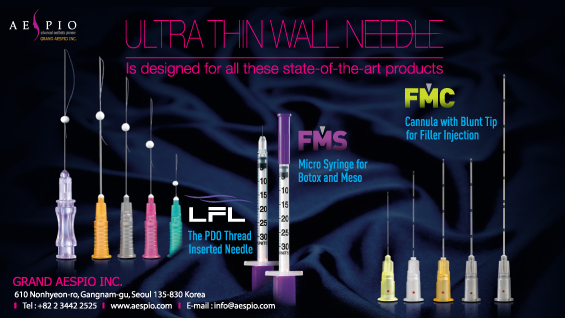
Acne is a common skin condition not only in adolescence but adulthood and tends to be chronic with high recurrence rate. Acne is likely to result in visible scars that lower the patients’ aesthetic and psychological quality of life. Various treatment modalities have become available for acne, however, the fundamental method that prevents recurrence is yet to be developed. The recent introduction of AGNES that selectively destroys sebaceous glands offers hope of drastically lowering the recurrence rate.
The following important pathophysiological changes characterize acne; increased sebum production, follicular hyperkeratinization and colonization of P. acnes with inflammatory changes.
[Advertisement] ULTRA THIN WALL NEEDLE – Manufacturer: AESPIO(www.aespio.com)
Acne occurs in sebaceous glands. The causative bacterium of P. acnes disintegrates sebum and excretes it in the form of free fatty acid which drives inflammation. Considering these pathophysiological characteristics, the target of acne treatment becomes quite clear.
Acne is a type of folliculitis occurring in sebaceous glands. Therefore, if sebaceous glands do not exist, neither will acne. In other words, as permanent hair removal can be achieved by destroying hair roots, sebaceous glands should be destroyed to prevent recurrence of acne. Treatment modalities such as medication, laser or PDT do not completely remove sebaceous glands and discontinuation is often followed by hormonal imbalance leading to recurrence of acne. These recurring acnes leave serious scars on the patient’s face. However, when sebaceous glands are destroyed, the subsequent hormonal imbalance does not induce acne recurrence.
Sebaceous glands can be removed by an electrocautery or CO2 laser. However, these devices are not safe as they damage the surrounding epidermis and dermis when targeting sebaceous glands. A safe and efficacious treatment would have to selectively destroy sebaceous glands, yet not burn the epidermis. The micro insulated needles of AGNES are designed to deliver energy only to the level of sebaceous glands without causing epidermal burns, promising safe and efficacious outcom

Figure 1. Mechanism behind selective destruction of sebaceous glands
Kobayashi et al. performed selective destruction of sebaceous glands using high frequency waves and micro insulated needles on the human face (cheeks). They evaluated the outcome with biopsy and sebum secretion rate. <Figure 2> shows histological images of tissues 15 minutes after selective destruction of sebaceous glands. Image A shows that epidermis down to follicular infundibulum are not damaged by high frequency energy, whereas Images B and C show destroyed sebaceous glands in the same depth. They measured long-term changes in sebum secretion rate and found that the sebum secretion was reduced 1 year after treatment. Based on the data in Kobayahi’s study, I could determine the optimal needle length, length of the insulated section, intensity of high frequency energy, duration of electricity application, and thickness of insulation, etc.

Figure 2. Histological images 15 minutes after selective destruction of sebaceous glands
-To be continued-
▶ Next Artlcle : AGNES reduces recurrence of acne by selective destruction of sebaceous glands Ⅱ





















